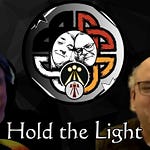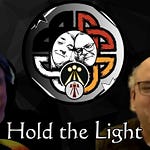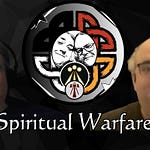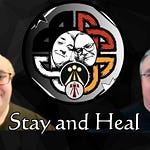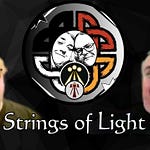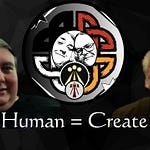Breath is so ordinary that we forget it is extraordinary. It comes unbidden, steady as a tide, unnoticed until something interrupts it. We know the sudden gasp of fear, the shallow rise and fall of exhaustion, the ragged breath when we are sick. Yet beneath all those moments lies the same truth: breath is life.
In this episode of Creation’s Paths, we began with the simple reminder that life in our breath is our life. Too often, spiritual traditions turn breath into something to control, to discipline, even to constrain. An effort at restraining life itself. But the practice we explored was not about constriction. It was about letting breath become prayer, letting the air itself speak the Name of the Divine.
This is the kind of practice that first feels like a gentle breeze on a cool fall day: soft, refreshing, peaceful. But it doesn’t stop there. Beneath that quiet surface, the practice deepens, grounding us like roots pushing into rich soil and rising like the charged air before a storm. Breath becomes both anchor and surge, weaving us into the great current of life.
The practice begins with ancient names. Matthew Fox, in his teachings on Radical Prayer, pointed to a way of praying the Tetragrammaton, the four-letter Name of God, by shaping the mouth and throat as though speaking YHVH while breathing in and out. No vocal cords, no sound, only the rush of air forming sacred syllables. The Name itself becomes breath.
Later, Rabbi Rami Shapiro deepened this understanding in Judaism Without Tribalism, distinguishing two ways we encounter the Divine: Yah, “I Am,” the inward presence; and Ehyeh, Being itself beyond us. Breath carries both: the inhale, “Yah,” turning us inward, centering us in selfhood; the exhale, “Ehyeh,” releasing us outward into community, creation, and relationship.
Jewish tradition also speaks of two inclinations, the yetzer ha-ra (the self-directed impulse, sometimes mistranslated as “evil”) and the yetzer ha-tov (the communal or altruistic impulse, “good”). Breath, again, becomes the place of balance: the inhale honors the self’s need for oxygen, life, renewal; the exhale honors the world’s need for creativity and creation it’s self. In this back-and-forth, the Name of God becomes the rhythm of our very existence.
Layered upon these roots are Creation Spirituality’s Four Paths: Positiva (awe and wonder), Negativa (letting go, emptiness), Creativa (birthing newness), Transformativa (healing and justice). Breath can move through these paths, each inhale and exhale carrying us through transformation, wonder, surrender, and creativity.
What begins as simply saying the Name with breath grows quickly into a deep meditation on self and cosmos. Inhaling, we are filled, self affirmed, grounded, alive. Exhaling, we are emptied, poured out for others, surrendered into communion. It is the yesh and the ayin, fullness and emptiness.
The practice reveals subtle truths: selfishness is not always evil, for inhaling is necessary to live. Selflessness is not always holy, for endless exhaling leaves us collapsed. We need both: the courage to take in life for ourselves and the generosity to release life for others. Brian put it plainly: if all we do is inhale, we faint; if all we do is exhale, we expire.
There is also mystery here. Each breath can feel like the ocean becoming a drop and the drop returning to the ocean. Each cycle of fullness and emptiness is a miniature creation, a tide that carries both the particularity of the self and the vastness of the cosmos. Thich Nhat Hanh called mindfulness the greatest magic because it brings us into the only moment that exists, the present. In this practice, mindfulness and prayer merge, each breath becoming spell, prayer, offering.
Breath touches everything. What I exhale becomes food for trees; what trees exhale becomes food for me. Breath connects species, people, and places into one vast circulatory system of life.
Prayed in this way, breath also connects traditions. It holds the Jewish mystical sense of the Divine Name too holy to speak, yet spoken in every breath. It carries the Christian vision of the Spirit as breath or wind (ruach, pneuma), moving in and through all. It resonates with Buddhist mindfulness of breathing as doorway to presence. It sits comfortably in Druidry, which sees the breath of the wind as the breath of the world.
Breath also connects the personal and the political. Our balance between inhale and exhale mirrors the balance between self and community, between individual needs and collective responsibilities. Too much inwardness leads to narcissism; too much outwardness leads to unthinking conformity. But when the two dance together, we breathe justice.
The advanced practice Brian offered makes this even more explicit: inhaling as transformation, holding in awe, exhaling as surrender, holding in creativity. This rhythm trains us not only to pray but to live: taking in the world’s wounds, holding them in wonder, releasing them in service, and pausing long enough to let new worlds gestate.
So how do we embody this? Begin simply. Sit or lie down comfortably. Let your shoulders relax. Inhale, shaping your mouth as though saying “Yah.” Exhale, shaping your lips as though saying “Ehyeh.” Don’t force sound, let the air itself be the word.
Feel the rhythm: fullness and emptiness. Notice the peace, like a cool autumn breeze. Notice the grounding, like roots drinking deeply. Notice the rising energy, like the charged air before a storm. Let your awareness sharpen until you feel not just your lungs but the whole web of life breathing with you.
Practice safely. Don’t force breath-holds. Don’t clench your throat. This is not a contest of endurance. It is prayer. Breathe naturally, gently, and if discomfort rises, release.
In time, you may add the pauses. After an inhale, hold for awe. After an exhale, hold for creativity. Let the Four Paths shape your breath: becoming, beholding, surrendering, birthing. Let the cycle turn until it becomes second nature, until every breath becomes a liturgy of transformation.
This is not meant to be lofty or distant. It can be morning centering, evening unwinding, or a quick re-grounding in the middle of the day. It can accompany your prayers, or it can be your prayer. What matters is that it keeps you alive to the presence of Spirit in and around you.
For me, this practice begins as peace: a soft breath, like the wind through trees on a fall afternoon. That peace sinks into my bones as grounding, reminding me that life is not abstract but in this air, this body, this earth. Then, without warning, the peace turns electric, a rising surge like storm-air alive with possibility. Awareness sharpens. Connection hums. I feel the life of trees, the pulse of animals, the hush of stones, all tied together by breath.
This practice reminds me that holiness is not locked in temples but carried in our lungs. Every inhale is the gift of being. Every exhale is the offering of self. Breath is the Name of the Holy One, spoken not with voice but with life.
And so my prayer is simple: may we learn to notice our breath. May we let it carry us into peace, root us in life, and awaken us to the storm-charged presence of the Divine all around. May each breath we take be offering, communion, and blessing.
Amen.
Thank you for Tips / Donations:
Substack: https://www.creationspaths.com/
New to The Seraphic Grove learn more
For Educational Resource: https://wisdomscry.com
Social Connections:
#christopagan #CreationSpirituality #breathprayer #mysticism #druidry #Brigid #breathwork #contemplation #sacredpractice #prayer
Chapters:
00:00 Introduction: The Divine Breath
01:07 Host Introductions
01:16 Overview of Divine Breath Practice
02:08 Matthew Fox's Radical Prayer Teaching
04:34 Understanding Divine Connection: Internal and External
15:08 Advanced Practice: Four Paths Breathing
18:15 Safety Guidelines for Breath Work
20:04 Closing Thoughts and Blessing






